Nrsg 533 - Study guides, Class notes & Summaries
Looking for the best study guides, study notes and summaries about Nrsg 533? On this page you'll find 24 study documents about Nrsg 533.
Page 2 out of 24 results
Sort by

-
Emory University NRSG 533 Exam 1 Blueprint Adult and Gero QUESTIONS AND ANSWERS
- Exam (elaborations) • 18 pages • 2023
-
Available in package deal
-
- $15.99
- + learn more
Fluid and Electrolytes - 17 questions (# in parenthesis next to objective) Objectives: 1. Identify body fluid compartments and summarize the movement of fluids (and electrolytes) throughout the compartments (1) - Hydrostatic Pressure (Capillary Filtration) - highest at arterial end (30 mmHg), lowest at venous (10 mmHg) - Colloidal Osmotic Pressure (Capillary Oncotic) - highest at venous end (28 mmHg) - Interstitial hydrostatic pressure - pushes fluid back into capillary - Interstitial...
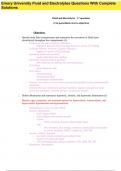
-
Emory University NRSG 533 Exam 1 Blueprint Adult and Gero QUESTIONS AND ANSWERS
- Exam (elaborations) • 18 pages • 2023
-
Available in package deal
-
- $15.99
- + learn more
Fluid and Electrolytes - 17 questions (# in parenthesis next to objective) Objectives: 1. Identify body fluid compartments and summarize the movement of fluids (and electrolytes) throughout the compartments (1) - Hydrostatic Pressure (Capillary Filtration) - highest at arterial end (30 mmHg), lowest at venous (10 mmHg) - Colloidal Osmotic Pressure (Capillary Oncotic) - highest at venous end (28 mmHg) - Interstitial hydrostatic pressure - pushes fluid back into capillary - Interstitial...
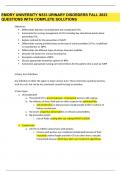
-
Emory University NRSG 533 Urine Disorder Handout ANSWERS FALL 2023
- Exam (elaborations) • 15 pages • 2023
-
Available in package deal
-
- $15.99
- + learn more
Objectives: Differentiate between uncomplicated and complicated UTIs. Summarize the nursing management of UTIs including key educational points about preventing UTIs. Explain methods for the prevention of CAUTI Differentiate nursing priorities base on the type of urinary problem (UTI vs. Urolithiasis vs Incontinence vs. BPH). Differentiate the different types of urinary diversion available. Describe risk factors for urinary incontinence. Recognize complicatio...
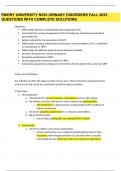
-
Emory University NRSG 533 Urine Disorder Handout ANSWERS FALL 2023
- Exam (elaborations) • 15 pages • 2023
-
Available in package deal
-
- $15.99
- + learn more
Objectives: Differentiate between uncomplicated and complicated UTIs. Summarize the nursing management of UTIs including key educational points about preventing UTIs. Explain methods for the prevention of CAUTI Differentiate nursing priorities base on the type of urinary problem (UTI vs. Urolithiasis vs Incontinence vs. BPH). Differentiate the different types of urinary diversion available. Describe risk factors for urinary incontinence. Recognize complicatio...
NRSG 533 MN adult exam 3 questions with complete solutions 2024
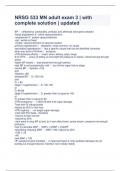
-
NRSG 533 MN adult exam 3 | with complete solution | updated
- Exam (elaborations) • 16 pages • 2023
- Available in package deal
-
- $9.99
- + learn more
NRSG 533 MN adult exam 3 | with complete solution | updated BP - -affected by contractility, preload, and afterload (strongest variable) -block angiotensin II - block vasoconstriction -angiotensin II - potent vasoconstriction -epi - works on heart -noripe- vasoconstriction of vascular system primary hypertension - idiopathic, most common, no cause secondary hypertension - has a specific cause that can be identified corrected when you think HTN think - ischemia HTN ischemia ...
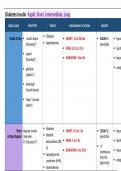
-
Emory University NRSG 533 Diabetes Drug Lists Questions With Complete Solutions
- Exam (elaborations) • 7 pages • 2023
-
Available in package deal
-
- $12.99
- + learn more
Rapid Acting insulin lispro (Humalog®) aspart (Novolog®) glulisine (Apidra®) Admelog® (insulin lispro) Fiasp® (insulin aspart) diabetes hyperkalemia ONSET: 15 to 30 min PEAK: 0.5 to 2.5 hr DURATION: 3 to 6 hr CLEAR SC injectable hypoglycemia lipohypertrophy hypokalemia weight gain 15 minutes before a meal or with meal (do NOT give if food is not there yet) 45 to 90° angle (SC) small needle (28...
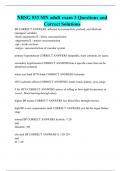
-
NRSG 533 MN adult exam 3 Questions and Correct Solutions
- Exam (elaborations) • 28 pages • 2023
- Available in package deal
-
- $14.49
- + learn more
NRSG 533 MN adult exam 3 Questions and Correct Solutions
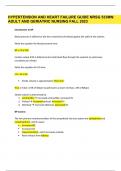
-
Emory University HYPERTENSION AND HEART FAILURE GUIDE NRSG 533MN: ADULT AND GERIATRIC NURSING FALL 2023
- Exam (elaborations) • 11 pages • 2023
-
Available in package deal
-
- $12.99
- + learn more
Introduction to BP. Blood pressure is defined as the force exerted by the blood against the walls of the arteries. Write the equation for blood pressure here: BP = CO x SVR Cardiac output (CO) is defined as the total blood flow through the systemic or pulmonary circulation per minute. Write the equation for CO here: CO = SV x HR Stroke volume is approximately 70mL/min True or False: A HR of 50bpm would lead to a lower CO than a HR of 80bpm Stroke volume is determined by: 1. Contra...
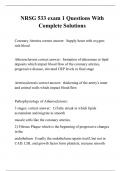
-
NRSG 533 exam 1 Questions With Complete Solutions
- Exam (elaborations) • 4 pages • 2023
-
Available in package deal
-
- $10.99
- + learn more
Coronary Arteries Supply heart with oxygen-rich blood Atherosclerosis formation of atheromas or lipid deposits which impact blood flow of the coronary arteries, progressive disease, elevated CRP levels in final stage Arteriosclerosis thickening of the artery's inner and central walls which impact blood flow Pathophysiology of Atherosclerosis: 3 stages: 1) Fatty streak in which lipids accumulate and migrate in smooth muscle cells like the coronary arteries. 2) Fibrous...

How much did you already spend on Stuvia? Imagine there are plenty more of you out there paying for study notes, but this time YOU are the seller. Ka-ching! Discover all about earning on Stuvia



